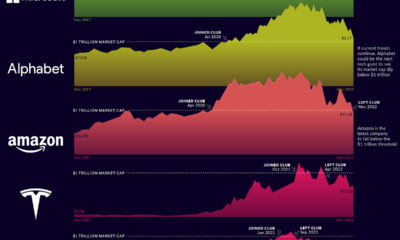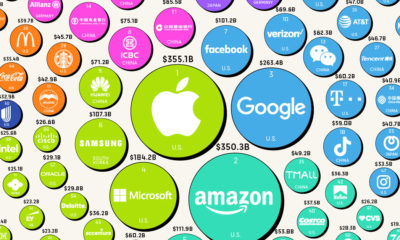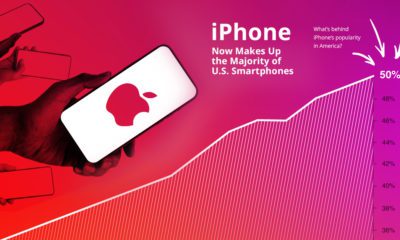Why Apple Watch is the Only Smartwatch That Matters
Apple’s business model has famously focused on proprietary ecosystems to maintain maximum control over how a product is designed and marketed to consumers. When the company whiffs on a design, it can lead to one of their many product flops. However, when Apple hits the nail on the head, it can be a game-changer. Before the launch of the Apple Watch, there was much debate among analysts as to whether it would even move the needle on revenues for such a massive company. Many took the position that although it would be big, that sales of the Apple Watch would not compare to other devices. Slice Intelligence, a company that data mines email receipts, so far estimates that Apple Watch sales as of mid-June were about 2.79 million. Further, about 17% of shoppers bought more than one high-margin band for the watch. Business Insider notes that the second-most popular second band is the more luxurious Milanese Loop, which sells for a lofty $149 and costs Apple just a fraction. The above infographic shows that it took 74 and 24 days to sell the first 1 million iPhone and iPad units. Meanwhile, it only took one day for Apple Watches to reach the same milestone. That’s more sales in one day than Android Wear did in the whole of 2014. Tim Cook said in an interview with Fast Company that the Apple Watch is the first smartwatch that matters. Based on initial sales numbers, this appears to be true. Android’s diversity of hardware makers and fragmented ecosystem has its advantages, but when it comes to entering a new category sometimes it is better to swing for a home run. What is less clear, however, is whether the Apple Watch will ultimately have a big enough impact to provide a catalyst to the company’s stock price. As of now, $AAPL is still hovering around a $715 billion market capitalization, which is still falling short of the technology company’s quest to hit $1 trillion in value. Enjoyed this infographic? Check out 37 Surprising Facts About Apple. Original graphic by: MobileSiri
on But fast forward to the end of last week, and SVB was shuttered by regulators after a panic-induced bank run. So, how exactly did this happen? We dig in below.
Road to a Bank Run
SVB and its customers generally thrived during the low interest rate era, but as rates rose, SVB found itself more exposed to risk than a typical bank. Even so, at the end of 2022, the bank’s balance sheet showed no cause for alarm.
As well, the bank was viewed positively in a number of places. Most Wall Street analyst ratings were overwhelmingly positive on the bank’s stock, and Forbes had just added the bank to its Financial All-Stars list. Outward signs of trouble emerged on Wednesday, March 8th, when SVB surprised investors with news that the bank needed to raise more than $2 billion to shore up its balance sheet. The reaction from prominent venture capitalists was not positive, with Coatue Management, Union Square Ventures, and Peter Thiel’s Founders Fund moving to limit exposure to the 40-year-old bank. The influence of these firms is believed to have added fuel to the fire, and a bank run ensued. Also influencing decision making was the fact that SVB had the highest percentage of uninsured domestic deposits of all big banks. These totaled nearly $152 billion, or about 97% of all deposits. By the end of the day, customers had tried to withdraw $42 billion in deposits.
What Triggered the SVB Collapse?
While the collapse of SVB took place over the course of 44 hours, its roots trace back to the early pandemic years. In 2021, U.S. venture capital-backed companies raised a record $330 billion—double the amount seen in 2020. At the time, interest rates were at rock-bottom levels to help buoy the economy. Matt Levine sums up the situation well: “When interest rates are low everywhere, a dollar in 20 years is about as good as a dollar today, so a startup whose business model is “we will lose money for a decade building artificial intelligence, and then rake in lots of money in the far future” sounds pretty good. When interest rates are higher, a dollar today is better than a dollar tomorrow, so investors want cash flows. When interest rates were low for a long time, and suddenly become high, all the money that was rushing to your customers is suddenly cut off.” Source: Pitchbook Why is this important? During this time, SVB received billions of dollars from these venture-backed clients. In one year alone, their deposits increased 100%. They took these funds and invested them in longer-term bonds. As a result, this created a dangerous trap as the company expected rates would remain low. During this time, SVB invested in bonds at the top of the market. As interest rates rose higher and bond prices declined, SVB started taking major losses on their long-term bond holdings.
Losses Fueling a Liquidity Crunch
When SVB reported its fourth quarter results in early 2023, Moody’s Investor Service, a credit rating agency took notice. In early March, it said that SVB was at high risk for a downgrade due to its significant unrealized losses. In response, SVB looked to sell $2 billion of its investments at a loss to help boost liquidity for its struggling balance sheet. Soon, more hedge funds and venture investors realized SVB could be on thin ice. Depositors withdrew funds in droves, spurring a liquidity squeeze and prompting California regulators and the FDIC to step in and shut down the bank.
What Happens Now?
While much of SVB’s activity was focused on the tech sector, the bank’s shocking collapse has rattled a financial sector that is already on edge.
The four biggest U.S. banks lost a combined $52 billion the day before the SVB collapse. On Friday, other banking stocks saw double-digit drops, including Signature Bank (-23%), First Republic (-15%), and Silvergate Capital (-11%).
Source: Morningstar Direct. *Represents March 9 data, trading halted on March 10.
When the dust settles, it’s hard to predict the ripple effects that will emerge from this dramatic event. For investors, the Secretary of the Treasury Janet Yellen announced confidence in the banking system remaining resilient, noting that regulators have the proper tools in response to the issue.
But others have seen trouble brewing as far back as 2020 (or earlier) when commercial banking assets were skyrocketing and banks were buying bonds when rates were low.














